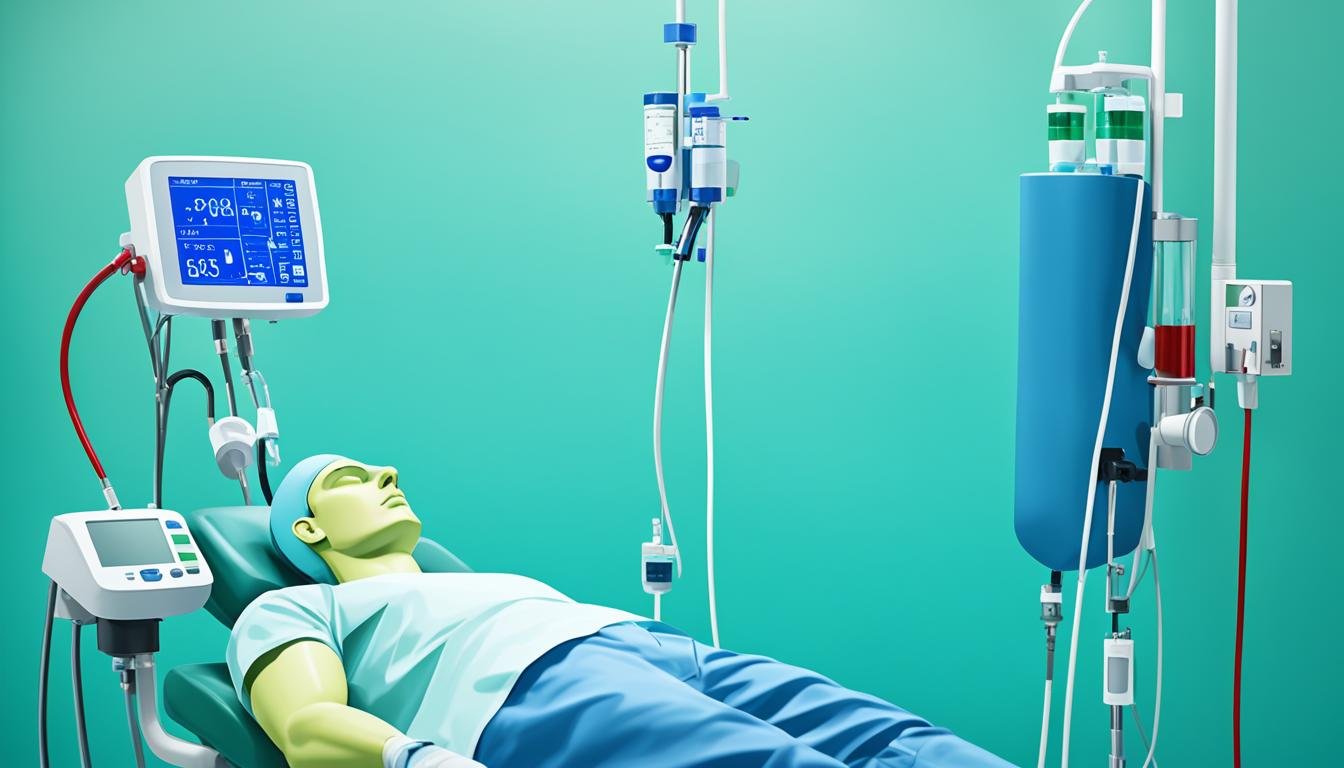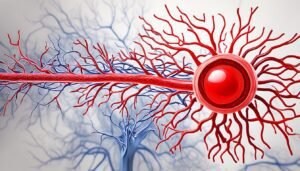Hypertension is found in many dialysis patients, affecting roughly 50-60% on hemodialysis (HD) and 70-80% on peritoneal dialysis (PD).1 The numbers can vary because different studies use different methods to define and measure high blood pressure. It’s very important to diagnose and manage hypertension well in this group. If left untreated, it can cause severe health issues like heart disease, stroke, and even death.1 This piece will explore how to manage high blood pressure in dialysis patients. We will look at using ambulatory BP monitoring and home BP checks, handling fluid levels, using certain drugs, and changing diet and lifestyle.
Key Takeaways
- Hypertension is highly prevalent in dialysis patients, affecting 50-60% of hemodialysis and 70-80% of peritoneal dialysis patients.
- Accurate blood pressure measurement using techniques like ABPM and home monitoring is essential for managing hypertension in dialysis patients.
- Maintaining optimal fluid balance through dietary and medication interventions is a crucial strategy for controlling blood pressure in dialysis.
- Pharmacological treatments, including beta-blockers and other antihypertensive medications, can help manage hypertension in dialysis patients.
- Dietary and lifestyle modifications, such as sodium/fluid restriction and exercise, can also contribute to better blood pressure control.
Understanding Hypertension in Dialysis Patients
Prevalence and Significance of Hypertension
Hypertension affects many dialysis patients. It touches 50-60% of those on hemodialysis (HD) and 70-80% of people on peritoneal dialysis (PD). These rates are higher than the general population’s 30%.23 Hypertension also raises the risk for heart disease, the top killer in the dialysis group.4
Factors Contributing to Hypertension in Dialysis
Several reasons contribute to why dialysis patients face high blood pressure. These include too much fluid, a system in the body that regulates blood pressure, over-stiffened arteries, and poor autonomic function.3
Consequences of Uncontrolled Hypertension
If high blood pressure isn’t controlled, dialysis patients can suffer serious effects. These include thickening of the heart muscle, heart failure, stroke, and worsening kidney condition.24 That’s why managing hypertension well is very important for these patients.
Accurate Blood Pressure Measurement in Dialysis
Before and after dialysis, blood pressure measurements are taken. These help diagnose and treat high blood pressure in dialysis patients. But, they might not show the patient’s true pressure levels spread out across time. This is because these readings can change due to how the body’s fluid levels change during dialysis.1
Limitations of Peridialytic Blood Pressure Measurements
These measurements might miss some of the patient’s overall blood pressure picture. They are affected by dialysis-related fluid movements and changes in the body’s blood flow. Thus, they might not fully represent the patient’s real blood pressure load over time.1
Ambulatory Blood Pressure Monitoring (ABPM)
Ambulatory BP monitoring (ABPM) is the best way to diagnose high blood pressure in dialysis patients. It records blood pressure for 24 hours between dialysis at home. It provides a more accurate view of the patient’s blood pressure around the clock. Studies show it’s better at predicting health problems than regular dialysis-based readings.5
Home Blood Pressure Monitoring
Monitoring blood pressure at home also gives important info. It’s better than peridialytic measurements at predicting health risks. So, checking blood pressure at home helps in finding high blood pressure in dialysis patients.15
Understanding blood pressure well is key in managing hypertension among dialysis patients. Using methods like ABPM and home monitoring alongside the traditional readings can give a more complete picture. This comprehensive approach is crucial for better care and patient health outcomes.
Relationship Between Blood Pressure and Mortality
The link between blood pressure (BP) and death is different for people on dialysis compared to the general population. Studies show a U or L-shaped connection between BP and the risk of dying in dialysis patients. This means both low and high BP levels can be risky.4 The reasons behind this “reverse epidemiology” are not fully known. It might have to do with the many factors like volume status, malnutrition, and inflammation affecting BP and mortality.4
U-Shaped or L-Shaped Association
Most studies in dialysis patients support a U-shaped model. This shows that extremely high or even “normal” BP levels can increase mortality risk.4 When BP goes beyond 120/80 mmHg, the risk of dying from heart or brain issues rises. And, reaching hypertension levels of 140/90 mmHg triples the risk of dying from these diseases.4
Role of Blood Pressure Variability
Blood pressure changing a lot, known as variability, is also a threat among dialysis patients. Factors like shifting fluids and autonomic dysfunction contribute to this.4 Interestingly, the variability in BP might matter more than the actual BP numbers for predicting outcomes.4 Those who experience a big BP drop during dialysis are at a higher risk for serious heart and circulation issues.4 Plus, there seems to be a connection between BP levels pre and post dialysis and a patient’s, future.4
More studies are necessary to figure out the best BP goals and the impact of BP variability on dialysis patients.
how to control high blood pressure during dialysis
It’s vital for dialysis patients to keep their fluid balance just right to control their blood pressure.3 They can do this by watching their intake of sodium and fluids, removing excess fluid during treatment, and taking diuretics.6
Pharmacological Interventions
Medicines are a key part of keeping high blood pressure in check for dialysis patients. Experts are looking into which medicines work best. Evidence now shows that beta-blockers could be a great choice.6 They work by lowering high heart activity and thickening of the heart muscle. These changes often lead to heart problems in dialysis patients.
While beta-blockers are important, medicines that target a different system in the body, and calcium channel blockers, could also help. But, it depends on each patient’s health and how well they can tolerate the medicine.
Role of Beta-Blockers
Studies have found that β-blockers do a better job at lowering blood pressure and guarding against heart problems in dialysis patients.6 This is because they help reduce high heart activity and heart muscle thickness, dangers that dialysis patients often face.
Hypertension Management in Peritoneal Dialysis
Hypertension is common among patients on peritoneal dialysis (PD), affecting 70-80% of them.3 The causes of hypertension in PD are many, like too much fluids, a hyperactive blood system, and stiff arteries. This group’s interaction with blood-flow-changing hemodialysis is less so.7 Still, getting their blood pressure right is a big challenge.
Prevalence and Risk Factors
Almost 80% of peritoneal dialysis (PD) patients have hypertension, which is high compared to others.3 This high number is due to too much fluid, a very active blood system, and stiff arteries.
Blood Pressure Monitoring Strategies
PD patients, like HD patients, should use special blood pressure checks. Devices for home or on the move monitoring, not just during treatment, give the best results.1 For HD patients, home monitoring has made their hypertension checks more accurate.7 Also, for those on home dialysis, including PD, managing hypertension well is linked to living longer.
Special Considerations for Blood Pressure Control
Dialysis patients have unique hurdles to jump for good blood pressure. They often face intradialytic hypotension during their dialysis. This can lower organ blood flow and cause bad health issues.6 Doctors must watch the patient’s fluid levels, use specific drugs, and tweak their dialysis treatment to prevent low blood pressure during therapy.6
Intradialytic Hypotension
Autonomic dysfunction is also a big issue for these patients. It can swing their blood pressure too high or too low.6 To help, doctors might use midodrine or similar drugs to make the patient’s blood pressure more stable. This cuts down on risks.6
Autonomic Dysfunction
Managing the risks of intradialytic hypotension and autonomic dysfunction is key for dialysis patients’ blood pressure.63
Dietary and Lifestyle Modifications
Making changes in what you eat and how you live can really help control high blood pressure for people on dialysis.8 It’s key to limit how much salt and fluids you take in. Doing this helps prevent too much volume in your blood and can lower your blood pressure.9 Also, getting regular exercise and keeping your weight in check is good for managing your blood pressure and heart health when you’re on dialysis. Doctors and dietitians should team up with you to create a diet and lifestyle plan that fits your needs.
Sodium and Fluid Restriction
For folks on dialysis, eating 8-10 ounces of proteins each day is important. Make sure to keep portions in mind, with 3 ounces about the size of a deck of cards or a medium pork chop.8 A good meal plan example includes 2150 Calories, 91 grams of protein, 2300 mg of sodium, 1800 mg of potassium, 950 mg of phosphorus, and 38 fluid ounces.8 It recommends adding “fish” meals to your weekly rotation because of the omega-3 fats that are great for your heart.8 Stay away from foods that are high in sodium, potassium, and phosphorus. There are detailed tips in the brochure for each food group, like proteins, grains, dairy, fruits, veggies, drinks, and desserts, all based on what’s best for dialysis patients.
Exercise and Weight Management
It’s important for dialysis patients to watch how much fluid they have to avoid health issues like cramps and heart trouble. Staying active and keeping your weight under control helps with your blood pressure and heart health.9 Your healthcare team can help you make a plan that’s just for you. This plan will include ways to manage your blood pressure through diet and lifestyle tweaks.
Individualizing Blood Pressure Targets
The best blood pressure goals for dialysis patients are not clear cut. The link between blood pressure and death is different in these patients than in the general public.3 Doctors suggest setting specific blood pressure targets for each patient. Factors like age, other illnesses, and how well their kidneys are working should be thought about.
Age and Comorbidities
For older dialysis patients and those with serious heart problems, a looser blood pressure target might be safer. This is because going too low can be risky.1 However, younger patients with better kidney function might need a tighter control. This helps slow down their kidney and heart issues.1 Doctors need to look closely at every patient to set the right blood pressure target.
Residual Kidney Function
If a dialysis patient’s kidneys are still doing some work, it changes their blood pressure goal.3 Those with better kidney function may need to keep their blood pressure lower. It can help protect their kidneys and hearts.1 But for those with little to no kidney function, the rules might be different. A more adaptable plan could be better for them.
Challenges and Barriers to Effective Management
Managing hypertension in the dialysis population faces many hurdles.10 People sometimes struggle to follow diet, fluid, and medicine rules, leading to high blood pressure. This happens because of issues like forgetting, feeling down, or not having enough support.11 Moreover, getting the right care and buying the needed medicine and equipment can be too expensive. This is especially hard for those who can’t easily afford it. To help, doctors can teach patients, make decisions together, and involve more team members to guide treatment better.
Patient Adherence
It’s tough for dialysis patients to stick to their diet, handle fluids, and take medicines as needed for hypertension.10 For some, memory problems, depression, or tough life situations make it even harder. This can lead to not controlling blood pressure well.
Access to Care and Treatment Costs
For many, reaching special care and paying for the right drugs and checks is not easy.11 This makes controlling hypertension hard, especially for those with fewer resources. Doctors are trying to break down these obstacles by teaching patients and making decisions together. They’re also involving more experts to help keep blood pressure in check.
Emerging Therapies and Future Directions
Dealing with hypertension in dialysis patients is a big challenge. Researchers look into new ways to control blood pressure.1
Novel Antihypertensive Agents
Newer types of drugs for high blood pressure are being developed, like sympatholytic drugs. They could give more choices to manage hypertension in people on dialysis.1 But, we need more studies to check how safe and effective these new treatments are for dialysis patients.
Interventional Approaches
There’s also a focus on procedures to lower high blood pressure. Treatments like renal denervation and baroreflex activation therapy are being tested.12 Yet, research is ongoing to determine their safety and long-term success for dialysis patients.
Multidisciplinary Approach to Care
Managing hypertension in dialysis patients takes a team approach. This team includes nephrologists, cardiologists, nurses, dietitians, and pharmacists.13 Each person on the team has a key role in helping dialysis patients with their challenges. Nephrologists and cardiologists work together to control blood pressure well.13 Nurses and dietitians help with things like watching fluids, changing diets, and taking medicines right.13 Pharmacists are important for managing medicines, checking for bad reactions, and making sure patients get the right doses with their kidney problems.13
Role of Healthcare Professionals
Nephrologists and cardiologists craft custom plans based on the newest advice and what works best.13 Nurses are key in teaching patients about fluids and medicine as well as watching blood pressure closely during dialysis.13 Dietitians help by making meal plans that fit the patient’s dietary needs, like limiting salt and fluids.13 Pharmacists double-check that high blood pressure drugs are used correctly and watch for bad reactions or other medicine problems.13
Patient Education and Empowerment
Teaching and helping patients become active in their health is vital.13 Being involved and learning to manage their own care is key for patients to keep their blood pressure in check.13 Doctors and their teams join forces with patients to make sure they fully understand their health plan. They teach patients how to see if their condition is getting worse and how to stay involved in their own care.13 This teamwork between patients and their healthcare group helps patients to decide wisely about their health and be hands-on in managing their condition.13
Conclusion
Controlling high blood pressure in dialysis patients is tricky. It involves many steps. Accurate blood pressure measurement is key. This includes using methods like ambulatory BP monitoring and home BP monitoring.2
Maintaining euvolemia by watching what you eat and drink is vital. So is taking certain medicines. But, there’s no single way to manage this. Beta-blockers and other drugs, plus changing your daily habits, can be game-changers. They help keep blood pressure in check and lower the risk of heart problems.2
Dialysis patients face specific issues, like fainting during treatments and trouble regulating their blood pressure. It’s important to set blood pressure goals for each person. A multidisciplinary care team plays a big role. They work alongside patients, offering support and knowledge. This approach helps handle high blood pressure effectively. It also leads to better health outcomes.2
The key to managing high blood pressure in dialysis is personalization. By using up-to-date methods and working closely with patients, doctors can make a real difference. They help patients control their blood pressure better. This lowers the chance of heart issues.214
FAQ
What is the prevalence of hypertension in dialysis patients?
What are the factors contributing to hypertension in dialysis patients?
What are the limitations of peridialytic blood pressure measurements in diagnosing and managing hypertension in dialysis patients?
How can ambulatory blood pressure monitoring (ABPM) and home blood pressure monitoring help in managing hypertension in dialysis patients?
What is the relationship between blood pressure and mortality in dialysis patients?
How can maintaining euvolemia help control blood pressure in dialysis patients?
What is the role of pharmacological interventions in managing hypertension in dialysis patients?
How prevalent is hypertension in peritoneal dialysis (PD) patients, and what are the strategies for blood pressure monitoring in this population?
What are the special considerations for blood pressure control in dialysis patients?
What is the role of dietary and lifestyle modifications in managing hypertension in dialysis patients?
How should blood pressure targets be individualized for dialysis patients?
What are the challenges and barriers to effective management of hypertension in dialysis patients?
What are some emerging therapies and future directions for managing hypertension in dialysis patients?
How can a multidisciplinary approach help in managing hypertension in dialysis patients?
Source Links
- https://www.ncbi.nlm.nih.gov/pmc/articles/PMC2552978/
- https://www.ncbi.nlm.nih.gov/pmc/articles/PMC6788847/
- https://clinicalhypertension.biomedcentral.com/articles/10.1186/s40885-023-00240-x
- https://www.nature.com/articles/s41440-023-01279-x
- https://www.ncbi.nlm.nih.gov/pmc/articles/PMC10472689/
- https://pubmed.ncbi.nlm.nih.gov/30084190/
- https://www.davita.com/treatment-services/peritoneal-dialysis/blood-pressure-and-peritoneal-dialysis
- https://www.kidney.org/atoz/content/dietary_hemodialysis
- https://www.davita.com/treatment-services/dialysis/on-dialysis/lifestyle-changes-on-dialysis
- https://www.ncbi.nlm.nih.gov/pmc/articles/PMC9655663/
- https://bmcnephrol.biomedcentral.com/articles/10.1186/s12882-020-01731-x
- https://www.ncbi.nlm.nih.gov/pmc/articles/PMC8942929/
- https://www.ncbi.nlm.nih.gov/pmc/articles/PMC10241769/
- https://www.ncbi.nlm.nih.gov/pmc/articles/PMC7215236/




